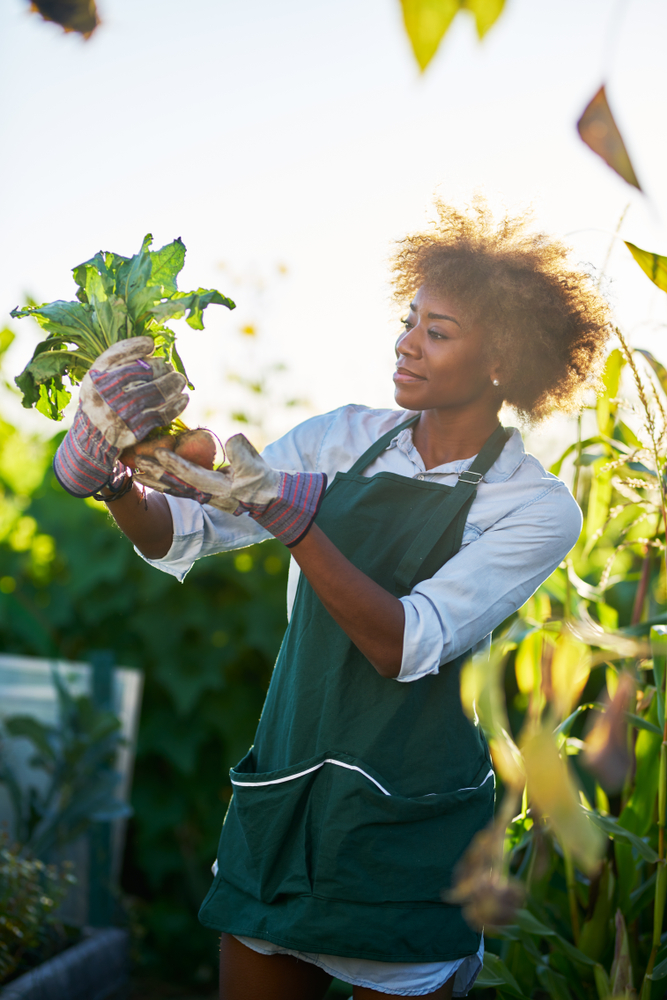

14697 Delaware St Ste 1200
14697 Delaware St Ste 1200
A Beginner’s Guide to Starting Your Own Vegetable Garden
Everyone these days seems to have a fiddle-leaf fig or devil’s ivy or a couple of each. Caring for houseplants can provide a sense of calmness and serenity, so we get the desire to do so. A bit of greenery is always good for the soul.
But what if we took that fiddle-leaf fig obsession a step further and launched it into your very own vegetable garden?
Contrary to popular belief, you don’t need a giant backyard to have a nice garden. You really only need a windowsill that provides a good amount of sunlight or a tiny outdoor space that gives you enough room to grow a handful of tomatoes, carrots and cukes.
Here’s how to get up close and personal with nature by setting up your very own vegetable garden.

Step 1
Start Small
If you’re a beginner, try starting small. Gardening is really hard work – it takes a lot of time, effort and patience.
It makes sense to start small and learn the gardening basics before committing a good amount of time and money to the project. At the end of the day, there’s no need to jump right in with 10 different lemon and avocado trees. You’ll end up spending countless hours outside planting, watering and weeding.
A beginner-sized vegetable garden can be simple. Pick 3-5 vegetables to grow, and work to master each of them. Don’t worry, your summer veggie inventory will still be plentiful.
You can even choose super affordable options, like tomatoes or some of your favorite herbs. Tomatoes are actually some of the most economical vegetables you can pick. Ten pounds may cost you around $20 in the long run. That will be much more affordable than 10 pounds of tomatoes from Whole Foods. Plus, they’ll be infinitely more flavorful.
Tip: If you don’t have a sunny 1-acre yard, fret not. Most of us don’t. Did you know that vegetables can grow in containers too? Try placing them on a sunny deck, windowsill or balcony. That’ll work just fine.
Step 2
Only Grow Veggies That You Love
We mentioned this earlier, but it’s important to emphasize that vegetable gardens are hard work and take a special level of commitment. That’s why you should only grow the veggies that you like to eat.
Before picking up the shovel, think about what you and your family will eat once the produce is ready. Can you freeze it? Will you eat it all? Be realistic about how many seeds to plant. Many beginners make the mistake of planting too many seeds, which can prove to be overwhelming once the sprouting process begins.
If you pick a veggie that you love and plant enough to last you for the season, the chance for successful crops increases immensely. Vegetables like tomatoes, squash and peppers are good options. They’re known to provide fresh produce throughout the season. They’re the gift that keeps on giving.
Corn, radishes and carrots, on the other hand, are harvested once and that’s it. Something to consider when deciding what will be housed in your garden.
Step 3
Pick the Spot
Now that we’ve set expectations, it’s time to start making moves, and that begins with choosing your growing site. Be thoughtful about this decision. It could make or break your garden.
Try to find a place that’s closer to your house or apartment. You have to be willing to venture out every day or every other day to check on your babies (aka veggies). The droopy ones will need water, and the ripe ones will need to be picked. With a handful of herbs in your hands, trekking back to your home will be much easier if your garden’s nearby.
Remember- the three pillars of success with any garden are:
SUN
You’ll have to consider the sun, which is arguably the most important factor when deciding on location. All plants need photosynthesis to kickstart growth. Fast-growing veggies need around 6-8 hours of direct sunlight, without any blockage from trees, fences, etc.
Of course, that’s not always doable, but try your best. Vegetables are both sun-loving and shade-hating.
And don’t forget — the sun moves throughout the day. If your garden is oriented from north to south, your veggies are likely to get maximum exposure.
WATER
Hydration is key when it comes to gardening, especially in warmer, drier areas. During the first few weeks after your seeds have been planted, be sure to give them frequent water.
Once established, you can start to give your garden a big gulp of water every few days, rather than a quick sprinkle every day.
Consider the composition of your soil as well. Sandy soil tends to dry out faster than clay soil, for example. Additionally, more sun and wind will lead to drier conditions. You can test the soil by feeling around 3-4 inches down. If it feels dry, feed it some water.
SOIL
The soil is the house where your plants will live and grow. Make sure it’s comfortable for them. Keep your soil rich and healthy with some of the tips listed above, like giving it plenty of water and full sun exposure.
You can also prep the soil before planting. Try spreading additives into it, like compost. Avoid stepping on freshly spaded soil. Rake the surface into a smooth, even texture. Water it regularly. There are a number of steps you can take to properly ready the soil before you plant.
Gardening should seriously be considered a form of therapy. You’re quite literally caring for something, watching it grow and flourish over time. Plus, what sounds better than fresh veggies in the summer? A vegetable garden can provide you both of those things. It just takes a little bit of TLC.
Terra Arzberger

14697 Delaware St Ste 1200
Westminster, CO 80023
303-920-9202
[email protected]
https://terraa.remax.com
100069668
I’d love to hear from you! Feel free to send me a message.
Terra Arzberger

14697 Delaware St Ste 1200
Westminster, CO 80023
303-920-9202
303-898-9345
[email protected]
https://terraa.remax.com
100069668
We Are Salient
Far far away, behind the word mountains, far from the countries Vokalia and Consonantia, there live the little blind texts. The Big Oxmox advised her not to do so, because there were thousands of bad Commas.
